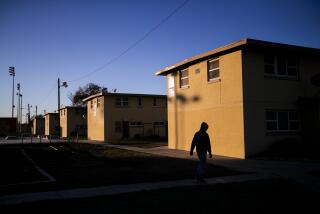A New Watts Awaits Visit by President
When President Clinton visits Watts on Thursday as part of a national tour showcasing poor neighborhoods and efforts to fix them, he will encounter a community vastly different from the one seared by fires and rioting almost 34 years ago.
If Watts once symbolized the poverty and tension gripping South-Central Los Angeles, the community now reflects the mixed results of post-riot economic infusion, as well as a surge of Latino immigration that has radically altered the ethnic makeup of the area.
At one time a gateway for Southern blacks, the 4-square-mile community at the southern edge of the city has now been transformed by an influx of Central American and Mexican immigrants, ushering in new tensions and triumphs.
Spanish-language shops and churches have sprung up to cater to new Latino residents, now more than half the local population. Bilingual banners line the boulevards.
Once the “quintessential African American ghetto,” Watts is now home to just as many Spanish speakers as English speakers, said Joe Hicks, head of the city’s Human Relations Commission, who lived near Watts during the 1965 riots. “It’s changed the political and economic dynamics. . . . There’s a new vibrancy.”
At the same time, efforts to jump-start economic revitalization have come in fits and starts. A new shopping center, civic center and library have spruced up the 103rd Street corridor--the area dubbed “Charcoal Alley” in 1965.
A new campus for the high school medical magnet opened a few months ago, and a cultural center and retail market is being built around the famous Watts Towers, now under renovation.
But some residents complain that promises of significant economic investment made after the 1992 civil unrest have not panned out.
“There’s been a lot of money supposedly dumped this way, but it’s not trickling down,” said Daude Sherrills, 31, a community activist who lives in the Jordan Downs housing projects. “The government made a lot of promises . . . but nothing crystallized.”
Added Sweet Alice Harris, a longtime community activist: “We still have a generation of untrained young people. We have to build up their hope.”
Signs of Rebirth, Signs of Stagnation
Conscious of the images of burning buildings often conjured up by the name “Watts,” residents said they hope that when Clinton visits, he will have a chance to see today’s Watts--a complex and often contradictory place.
On Santa Ana Street, near the Metro Blue Line tracks, a row of new two-story, stucco homes have sprung up. “Santa Ana Pines: New Homes for a New Watts,” proclaims the sign at the sales office. But around the corner, children splash in water spraying from a fire hydrant in front of sagging bungalows. Nearby, empty lots are strewn with trash.
At the Martin Luther King Jr. shopping center, a neat suburban-looking complex built in the 1980s, Latino and black families mingle as they shop at a large grocery store. Across the street, teenagers surf the Web on computers in the new Alma Reaves Woods library. But about a mile to the south, groups of unemployed men hang out in front of cinder-block apartments in the Nickerson Garden housing projects, grumbling that their opportunities remain limited.
Despite the promises made after the 1992 riots, many complain that real economic transformation hasn’t come to Watts, where the average per capita income in 1996 hovered around $5,000, compared with about $18,000 in Los Angeles County overall. Until there are enough jobs, residents say, the shopping center and new civic facilities merely mask the poverty gripping the community.
“We’re extremely underdeveloped,” said Janine Watkins, a director at the Watts Labor Community Action Committee. “We’ve got a new library and civic center . . . but in regards to business and employment in the area, it’s still really limited. This area is still neglected.”
The list of needs is familiar to many urban areas: job training, well-paying employment, child care, affordable housing and loans.
But several grass-roots business efforts launched after the 1992 civil unrest fizzled out, including ventures such as Hands Across Watts and Playground, an athletic shoe store and community center Clinton visited while campaigning for president.
Government-backed programs intended to jump-start economic growth have had mixed results. A state enterprise zone created in 1986 that awarded tax breaks and other credits to local businesses created few jobs.
Some community leaders are also critical of efforts made by the Community Development Bank, saying the nonprofit institution designed to make loans and stimulate investment has not produced change locally.
Los Angeles was awarded a federal empowerment zone last year, after losing a bid for one in 1994. The program will provide tax credits and incentives to businesses in Watts and other poor areas. That designation, along with Mayor Richard Riordan’s creation of a tax-free zone in the area, has helped spark interest in investing in Watts, said Dan Margolis, a spokesman for the mayor. However, the federal empowerment tax breaks won’t kick in until 2000.
The slow progress has made many Watts residents skeptical of any more promises the president might make Thursday.
“It ain’t going to help us that Clinton is coming down here,” said resident Gregory Jones, 34, as he sat on some steps in Nickerson Gardens on a recent afternoon. “He’ll just suggest some things and leave.”
The lack of economic opportunity has also caused some friction between Latinos and African Americans, some who perceived the newcomers as a threat, saying that immigrants work longer hours for less money. Interracial violence has plagued the local schools and the housing projects.
“Some people were wrongly perceiving that Latinos were here to take the jobs and properties of African Americans,” said Arturo Ybarra, head of the Watts/Century Latino Organization. “That sometimes caused misunderstanding, conflict and confrontation.”
From its base in an old liquor store that was turned into a community center, Ybarra’s group brings together Latino and African American parents to deal with issues at the local schools. The 700-member group partners with other community organizations for gang prevention and cultural awareness programs. And it sponsors an annual Cinco de Mayo parade that draws thousands who come to see the mariachis, blues bands and traditional Aztec and African dancers.
“As Latinos and African Americans, it is important to learn about our histories,” Ybarra said. “We are sharing the same social conditions, the same space.”
Although the community has changed, Ybarra does not think many outsiders have an altered view of Watts. He is pessimistic that Clinton will address Latino concerns about immigration and other issues during his visit.
“I think he still has the wrong perception that Watts and South-Central are African American areas,” he said. “Someone has to tell him there are new dynamics, new challenges, new needs of the community.”
Watts Described as Great Place to Live
Now, the future of Watts may be people such as Gloria Soltero, who lives in a snug pink house in the shadow of the Watts Towers. She and her husband, who shines shoes for a living, moved from East Los Angeles 10 years ago, looking for an affordable home.
Soltero thinks the government needs to pay more attention to the community, but in general, says Watts is a great place to live. The neighborhood has become safer since a 1992 gang truce, she says, and residents take pride in their homes.
She counts her African American next-door neighbor among her good friends, and gazes with pride at the colorful spires of the Watts Towers that rise up in front of her porch.
“It’s like the Statue of Liberty,” she said. “We’re lucky to live here.”
More to Read
Sign up for Essential California
The most important California stories and recommendations in your inbox every morning.
You may occasionally receive promotional content from the Los Angeles Times.










